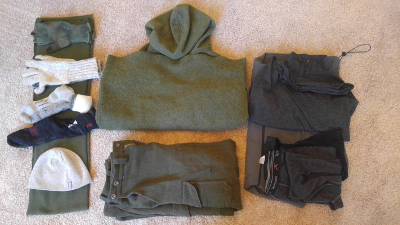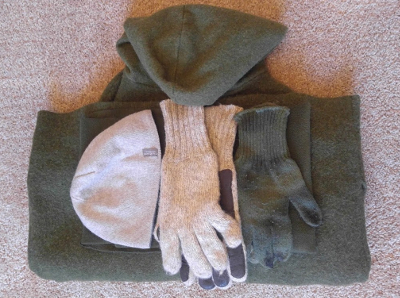Survival Clothing

Survival clothing - clothing that performs well in the wilderness in all weather conditions - is one of the most vital pieces of life-saving outdoor gear. Here we will cover principles of effective clothing as well as specific types to consider for outdoor use. Consider these important concepts along with your personal preferences to choose the best option for your situation.
Overview
What makes clothing effective is their ability to shield us directly from the elements and insulate us by trapping our body heat. There are countless variations on the theme, and many brands claim to be the best or most effective, but clearly not all of them pass the test in the field.
For starters, when considering effective survival clothing, you must break down what parts of the body you need to cover and what conditions you will be dealing with. Here are the major areas of the body to consider: your core, hands, feet, legs, head, and neck. Each of these areas need to be considered both together and separately.
Next, consider what kind of environment you will be dealing with. Context is a large part of what will work, because wearing a thin silk shirt in the arctic winter would be as ineffective as wearing thick wool in the searing desert summer.
It is useful to break up the clothing into specific layers. Base layers are those worn directly next to your skin. Outer layers are generally those which are exposed to the elements. Mid-layers are those which are worn in between base and outer layers. Layering is a very effective and intelligent way to deal with cold and with climates where temperatures can fluctuate rapidly in the course of a single day and night.
Materials
The kinds of materials in the clothing will determine how they work and what they are made for. There is a popular saying, "cotton kills." This means that once cotton clothing gets wet from rain or intense sweating, it loses its insulating value. This is great for warm or hot weather, where such quickly breathable clothing allows sweat to evaporate and cool your body. This is terrible, however, under conditions where you are depending on those same cotton clothes to keep you warm, say during a cold autumn downpour or a sudden blizzard!
Natural animal fibers, especially wool, are arguably one of the best all around materials in helping insulate our bodies in the cooler climates. Therefore wool clothing can be a significant part of your wardrobe for serious outdoor use.
Silk is a surprisingly effective and resilient natural fiber, and because it is very comfortable it is a great choice as a base layer for survival clothing.
Be More Prepared For Your Next Outdoor Adventure!

Don't leave without knowing these six essential survival skills. Our free survival mini guide reveals the strategies of:
- Shelter & fire to prevent the number one cause of death
- Obtaining clean water to avoid life-threatening dehydration
- Common wild survival foods and other critical skills!

Poly-fibers, such as Gore-Tex and related materials can be effective when used correctly. These are best as rain and wind-proof shells, worn as the most outer layer. These shells can be used with fewer under-layers during warmer times of the year merely as a way to reduce wind exposure. The challenges with using these fibers are that they often don't breath adequately and may encourage more profuse sweating. If they are vented properly by unbuttoning or unzipping, they can be incredibly useful.

Specific Types of Survival Clothing
I personally keep a bag full of survival clothing in the trunk of my car, so that in case of stranding or an accident I can be prepared. Since I live in the temperate Pacific Northwest, my clothing choices reflect dealing with cold and wet weather situations.
Here is what I include in this bag:
- A pair of good wool pants
- A pair of rain pants as an outer shell for very wet days
- A wool scarf
- 2 pairs of thick wool socks
- A thin, long sleeved wool shirt
- A thicker wool long sleeve shirt
- A fleece zippered sweater
- Wool glove liners (basically thin wool gloves that can fit into large outer layer gloves or mittens)
- A pair of thick poly-fiber gloves
- Very thick wool fingerless gloves (a backup for when the others get wet)
- A pair of wool underwear
- A large hooded wool jacket (which I use as an outer layer in all but the most extreme weather)
- A thick, wool beanie style hat
- A small stitching kit that allows me to do basic repairs on my clothing (including needles and threads of different colors)
- Thick plastic rain poncho (for dealing with the serious downpours). This can be made into an emergency shelter if the need arises.
What I do not include in this bag, but have both on my body and in my trunk is a good pair of shoes that fit me well and are waterproof. Wetness is a part of life here in the Cascades of the Pacific Northwest, so keeping your feet dry is a must. It wouldn't hurt to have an additional pair to switch into when your first pair gets soaked or damaged.
Additional Thoughts
In understanding how insulation works to trap air, you can also use natural materials (such as dry dead leaves) stuffed in between your layers to help give you added insulation if you need more. You can also purchase or make alterations to an existing jacket that will hold such materials. These liner spaces can be filled with anything from cattail down, newspaper, feathers, dry moss or dry leaves. If you are desperate, even wet leaves can give you some insulation as long as that wetness does not seep down to your skin and make you wet. You can stuff your pants in a very similar way for extra warmth.
Remember that the keys to effective survival clothing are insulation, proper use and ingenuity! Be creative and experiment with ways to make your gear match your needs. Test your gear in different environments and under different weather conditions.
By the way, if you enjoyed this article then you'll love our survival mini guide. You'll discover six key strategies to staying alive in the outdoors plus often-overlooked survival tips. We're currently giving away free copies here.
Additional Resources:
Learn more about survival clothing on the Wildwood Survival site.
Wilderness Survival Courses at Alderleaf

About the Author: Filip Tkaczyk is a periodic guest teacher at Alderleaf. He also wrote the field guide Tracks & Sign of Reptiles & Amphibians. Learn more about Filip Tkaczyk.
Return from Survival Clothing back to Wilderness Survival Articles
Is The Essential Wilderness Survival Skills Course Right for You? Take the "Online Survival Training Readiness" Quiz
See for yourself if this eye-opening course is a good fit for you. It takes just a few minutes! Get your Survival Training Readiness Score Now!

Grow Your Outdoor Skills! Get monthly updates on new wilderness skills, upcoming courses, and special opportunities. Join the free Alderleaf eNews and as a welcome gift you'll get a copy of our Mini Survival Guide.

 The Six Keys to Survival: Get a free copy of our survival mini-guide and monthly tips!
The Six Keys to Survival: Get a free copy of our survival mini-guide and monthly tips!
Learn more